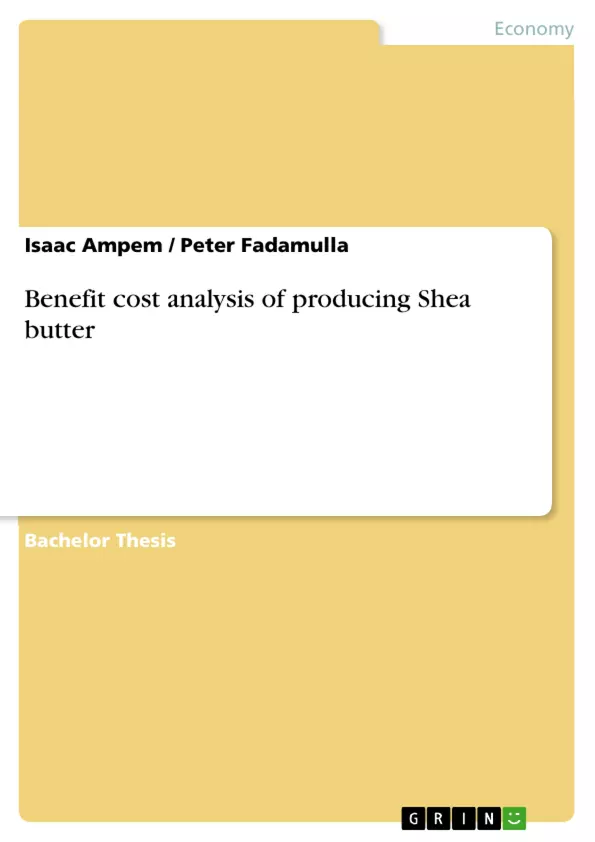This study aimed at analyzing the benefits, cost and constraints of production of quality Shea butter in relation to production methods amongst processors in Tamale Metropolis. Specifically, it was to assess cost-benefits of production of quality butter. Secondly, to determine the factors that influences marketable quality butter. Lastly, to analyze the constraints to the production of quality marketable Shea butter. The study was conducted in 4 communities in Tamale Metropolis because these are the communities with abundant shea butter processors. A total of 80 respondents were interviewed with 20 respondents being selected from each of the communities using snowball sampling. The average costs, average revenues and profits were calculated on yearly basis. The study revealed that averagely individual processes 3 bags (90kg each) of Shea nuts in a week and this yield 3 units of shea butter which weighs 25kg each. This yields an average of 75kgs of Shea butter selling at an average price of GHc73. A processor has an average total cost of GHc8609 per year, average total revenue of GHc10512 per year and the profit yielded is GH1622.8 per year. This gave a benefit cost ratio of 1.2:1 which implied that producing quality butter was profitable. Probit model was used analyze the factors influencing the quality of Shea butter. Out of the seven (7) estimated coefficients number of years in processing, improvement in technology and orderly processing procedures significantly explains the likelihood that a respondent produces quality Shea butter. The study also revealed that the major problems encountered by processors were; lack of capital to purchase enough nuts and expand production, unstable markets, high prices of nuts, dangers associated with picking nuts from the bush, shortage of water in lean season. The results of the Kendall‟s coefficient of concordance revealed fair level of agreement (40%) among respondents. On recommendation, Shea board should be rejuvenated to function effectively.
Table of Contents
- CHAPTER ONE
- INTRODUCTION
- Background
- Problem Statement
- Research Questions
- Objectives of the study
- Specific Objectives
- Justification
- Limitations of the Study
- Organization of the Study
- CHAPTER TWO
- LITERATURE REVIEW
- History of Shea Trees
- Description of the Shea Industry
- Investing into Shea Butter processing
- Shea butter Extraction
- Utilization of Shea butter
- Types of Shea Butter Processing Technologies
- Manual Traditional System of Production
- Semi-Mechanized System of Production
- Fully Mechanized System of Production
- Quality Standards in Shea Butter Industry
- Uses of Shea butter
- Traditional use of Shea in Africa
- Uses of Shea butter in the international market
- Shea Butter Marketing
- Traditional Market for Shea Butter
- International Market for Shea Butter
- Financing of Shea Butter Production and Marketing
- Sources of Finance
- SEKAF Ghana Limited Model
- Savannah Fruits Company Model
- Potentials of Ghana's Shea Butter Industry
- Contribution of Shea Butter Industry to Development in Ghana
- Financial income from Shea nut as a means of poverty reduction
- Government of Ghana's Involvement in the Shea Industry
- The Involvement of NGO's in the Shea Butter Industry in Ghana
- Factors Militating against Shea Industry
- Shea Butter Processing Constraints
- CHAPTER THREE
- RESEARCH METHODOLOGY
- Study Area
- Climate
- Data Collection Methods
- Population
- Sampling and Sampling Procedure
- Sources of Data
- Methods of Data Analysis
- Quote paper
- Isaac Ampem (Author), Peter Fadamulla (Author), 2014, Benefit cost analysis of producing Shea butter, Munich, GRIN Verlag, https://www.grin.com/document/288669



